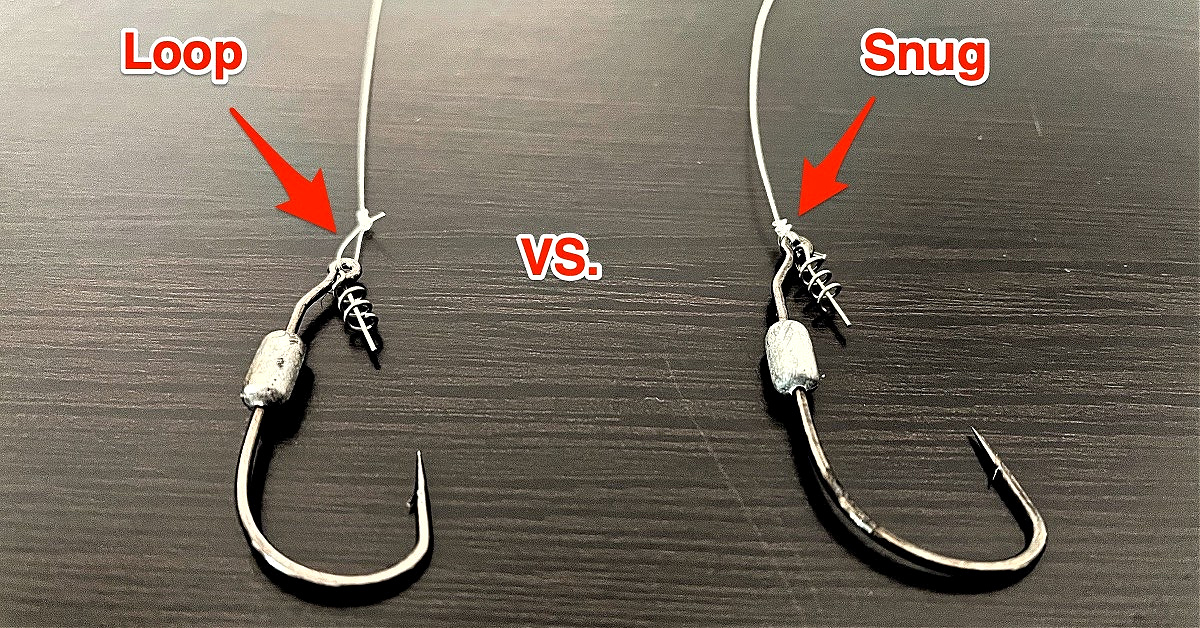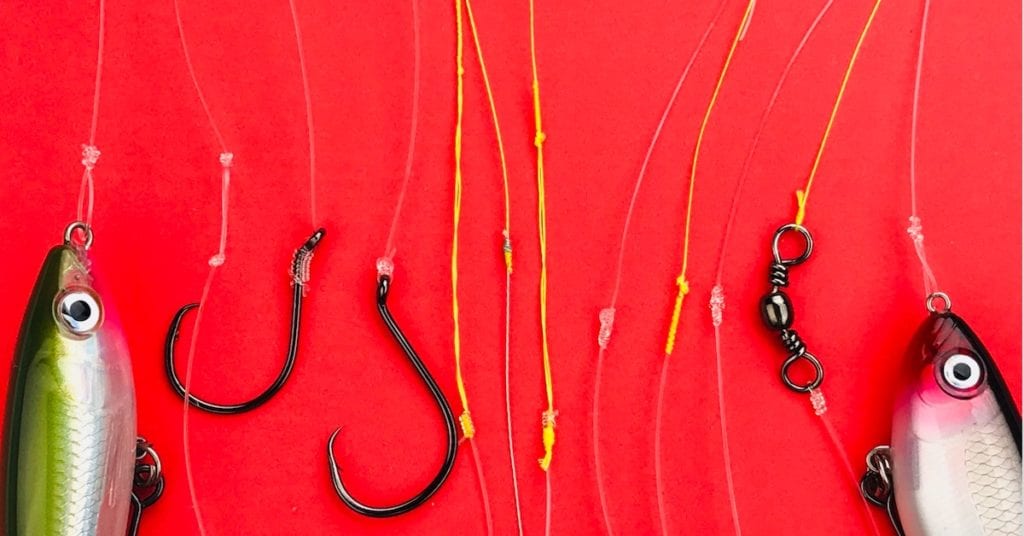Loop Knot VS. Snug Knot Comparison (Underwater Analysis)
- By: Tony Acevedo
- on

What are the differences between the loop knot and the snug knot when tied to soft plastic lures?
Is there a noticeable difference in how the knots affect lure presentation underwater?
Take a look below as we analyze some underwater footage of both the loop and snug knots!
Check it out here!!
Loop Knot VS. Snug Knot Comparison [VIDEO]

Equipment Used:
Alabama Leprechaun
The snug knot used in this analysis is the Trilene knot.
When reeling in the jerk shad underwater with the snug knot, the lure bounces up and down in a casual darting motion.
It doesn’t have a “dance” to it or any sort of movement other than bouncing up and down.
You want erratic action out of a jerk shad with more movement.
The snug knot hinders the overall intended action of the jerk shad.
On the other hand, the loop knot does not constrict the eye of the hook or the lure as it moves in the water.
Using a twitching retrieve with slight pauses, the lure dances and portrays an erratic motion when reeling it in.
The lure itself has more freedom of motion as it darts up and down and side-to-side.
Paddletail Lures
The first trial is a slow, straight retrieve of the paddletail tied onto the hook with a snug knot.
With the straightforward retrieve using a snug knot, there is a slight wobble of the lure as it swims in the water.
There is not much impact from the knot on the action of the lure.
When using a bouncing retrieve, the snug knot does restrict the lure more than a straight retrieve.
The tail of the lure restricts the action the most because it will keep the lure moving straight as opposed to the split-tail jerk shads that allow the lure to dive and dart.
Overall, the snug knot tied to a paddletail using a bouncing retrieve will be more up and down without much side-to-side movement.
If the paddletail is tied onto a hook with a loop knot, the lure still has a similar wobble to when it is tied on with a snug knot.
There are not any major differences in comparison between the two knots using a straight retrieve with the paddletail lure.
With regards to the bouncing retrieve, there is more of a visible difference between the two knots.
As with the jerk shad, the lure tends to fall in different directions because it has slightly more freedom of motion.
The kicking tail of the lure and freedom as a result of the loop knot lets the lure fall to different sides naturally.
Results
A jerk shad is a lure with natural darting action and you want to maximize that action with a loop knot.
In the case of paddletail lures, the tail of the lure restricts some of the movement because of resistance when it swims.
This will cause the lure to move straight whether you are reeling it straight in or bouncing it up and down.
As a result, you can get away with using either a loop knot or a snug knot for a paddletail lure.
It comes down to personal preference and how you want to tie your lures on your hooks.
The loop knot will not hinder any presentation, but it will only enhance the action of lures.
With that in mind, something to be aware of is the loop knot is going to be weaker than a snug knot.
If you prefer a stronger knot as opposed to better action on your lure, then you want to go with a snug knot.
Knots and lure choice are important but what is even more critical is locating the fish.
Conclusion

Fishing knots are at the center of everything for an angler and play an important role in the presentation of a lure and subsequent fight between you and a fish.
The loop knot and snug knots of various kinds provide slightly different effects to your lures and can hinder or enhance the action of your lure in some cases.
Be sure to keep in mind what type of lure you are using and how you want it to be presented when determining what knot you will choose to use.
If you have any further questions on knot selection, please ask me down in the comments!
And if you know someone who wants to learn more about knot selection and its effect on lure action, please TAG or SHARE this with them!
P.S. Want access to our best fishing spots and tips, plus discounts to our online tackle store? Click here to join us in the Insider Club!
Related Articles:
Related categories:
STOP WASTING TIME ON THE WATER!
Do what the “SMART ANGLERS” are doing and join the Insider Club.
Here’s what you’ll receive today when you join:
- Weekly fishing reports and TRENDS revealing exactly where you should fish every trip
- Weekly “spot dissection” videos that walk you through all the best spots in your area
- Exclusive fishing tips from the PROS you can’t find anywhere else
- Everything you need to start catching fish more consistently (regardless if you fish out of a boat, kayak, or land).










Tried & tested uni-knot… In this case the uni-loop knot.
Snug it up as usual, then using your thumbnail against your index finger at the base of the eye to slide it back on the mainline slowly. You can slide and make a loop any size you want. When a fish is hooked it will slide back down to snug position. You can slide it back again for the next cast.
I discovered this by accident many moons ago… The amazing uni-knot is one of the strongest, I can do it, trim it and slide it, eyes wide shut!
Tony, I use a Palomar knot for everything and it has yet to fail me. What are your thoughts on that one and would you do a video on it at some point?
Hey Tammi!
I have used the palomar knot with mono leader and it works great as a snug knot. Quick easy and strong. I wouldn’t recommend using it with fluoro. I have had the knot slip with fluoro since its a stiffer line (depending on the brand you use)
Thank you Tony for another informative and not too lengthy video. After watching this, I will definitely use a snug knot for paddletails. I like the action of the loop knot, but I have had the loop knot fail on big fish, and that is a heartbreaker.
You’re welcome Lara!
Tony, I like your video’s the best. They are not overly long and talky, right to the point and very beneficial to the subject on hand. I always prefer yours. Good work Tony.
Thank you for the awesome feedback Gene!
Great research thank you. I mainly use a small snap for ease of lure changing, does that working the same way as a loop knot?
My pleasure Steve! A snap will work the same as well. I prefer not to use them when using topwater lures or hard baits though because the snap weighs the line down and can cause the front hook of those lures to foul up on the line quite a bit.
Thanks Tony
You’re welcome Jerry!
hey tony great info and thanks. during the winter time here in homosassa, i go to a snug knot on mirr o dines, paddle tails and jerk shads to slow the action down due to the cooler water temps. seems to work well here. all the best
Thank you for the great feedback Drew! Great point!
As far as strength of loop knot, whenever I have gotten snagged and had to break off my line, it never seems to be the knot that fails.
Where do you feel that the break is occurring when you break off?
Since the eye of the lure slides and can rub the “loop” it will typically break through the single strand of line. Can be very situational though.
When finished fishing, how do you handle your lures? Do you remove them from jighead or cut off line? Doesn’t removing from jighead damage lure?
If I’m using zman elaztech lures, I usually add a dab of super glue, so I always leave those on until they have to be replaced. If I’m using a gulp lure, you obviously always wanna remove it from the jig head, or else they will dry rock hard and you’ll have to bust it up with pliers. Another thing to consider, if you are using any type of lure that has salt added to it; a zoom super fluke for example, you need to remove those after a day of fishing, even if they aren’t damaged. The salt in the lure will actually cause the jig head to rust, and rust VERY quickly! The SS 2.0, I have left several on the jig heads and have had no issues. I’ll sharper the hook with a finger nail file every other trip. Hope this helps!
If I plan to fish again within the next week or so I will just leave them on, but if they’re already pretty worn out or I wont be on the water for a while I will remove them so the hook doesn’t rust out from saltwater getting trapped between the hook and the plastic. I always replace my leader before my next trip.
does the size of loop make a difference, 1/4 inch length, of loop or 3/4 inch loop length
Hey Terry!
Not that I have noticed. The only difference I notice is with topwater lures or hard twitch baits. If the loop is too big you will have the front hook of those lures catch your line and foul up more. I like to keep it around 1/4″